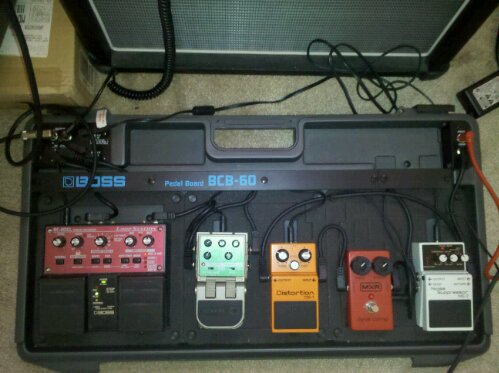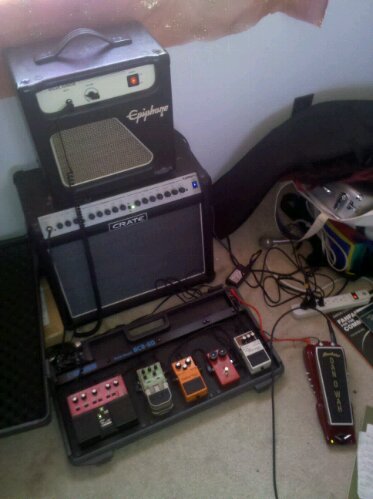In all the flurry of recent project completions and album releases, I thought I’d fire off a quick post here just ahead of my coming tours. (Make sure to check gangstagrass.com and manabout.horse for tour dates!)
I am so proud of Man About A Horse on the release of our first full-length album. I’d like to acknowledge the makers of fine musical instruments and accessories who helped make this possible.
BANJO: Nechville Midnight Phantom with Timbr-Tronic tone system
nechville.com/phantom.php nechville.com/timbrTronic.php
I picked up this banjo after two encounters with Nechville; first, at Tom’s booth at IBMA, and second, during a layover in Minnesota which I intentionally lengthened to give me time at their factory. Simply put, I found that the Timbr-Tronic system, which combines a wood tone ring, a ball-bearing system, and (in my case) a titanium cap on the wood ring, was able to reduce weight by several pounds and not sacrifice tone. It is the banjo I use when I play live with Man About A Horse as well as Gangstagrass, making it equally at home with bluegrass and hip-hop stage environments. It fits in a living room house concert and can fill a festival stage for 10,000. So naturally I felt most comfortable playing it in the studio, particularly because we were going for a live feeling in the session.
STRINGS: GHS PF170 Regular Light Stainless Steel Loop-End .09 .11 .13 .20w .09
ghsstrings.com/products/11246-stainless-steel-5-string
I have been using GHS strings ever since I started playing with Gangstagrass, which would be about four/five years now. I think I broke one once. I do enjoy the tone and playability of a fresh set, but I can often go for weeks without changing them. They’re easy to change, though, with the slots on the quick-change tailpiece and the guitar-style tuning pegs on my Nechville.
Good strings. They don’t stick, they don’t slip, and they sound great.
CAPO: Shubb Capo Noir C5k-r for radiused fretboard
shubb.com/noir/
I haven’t had to buy a new capo for a very long time; I always use the same Shubb C5 capo, and I own one for each banjo. But with the purchase of my Nechville, which has a radiused fretboard, I had to get a radiused capo. So I thought I’d try something fancy, and I got this really cool black capo. With the dark look of the hardware on the Midnight Phantom, it fits in really well. It feels lighter and sleeker than the typical Shubb capo but does the job just as well.
Buying this capo was kind of like buying the banjo, in that I knew I needed a new piece of hardware, so I might as well get one I really liked. The Phantom has a really, really great neck. The radiused fretboard and wide guitar-style frets make it comfortably playable and somewhat guitar-esque while still totally appropriate for traditional bluegrass technique. It does look somewhat non-traditional, though, which is fine for the bands I play in. Part of that non-traditional look is the fifth string. The tuning peg has been moved to the headstock, and the string travels through a tunnel to get there. This makes the whole neck stronger, much smoother, way more playable, and easier to restring to boot! Plus you can’t beat that eye-catching look. I love when people come up to me confused by the vanishing string, and I get to explain where it goes, like a magic trick!
PICKS: Dunlop brass 94530 thumb .0225 index .018 middle
jimdunlop.com/category/products/guitar+picks/finger+&+thumb.do?Material=100006-16
I use a brass thumbpick. Why? Two reasons.
One is that if everything is the same material, the sound will be more uniform. Yes, the thumb is stronger than the other fingers, and it can make the sound pop out more, but it just means you have to modulate your power.
The other is that I got tired of wearing through my plastic Dunlop thumbpicks. Only time I’ve ever had to replace a brass thumbpick is if I lost it, say, by removing my sweater, while wearing the thumbpick, at a jam at the Grisly Pear on the lower East Side, about seven years ago. Hypothetically. If anyone finds it, please let me know. That was a good pick.
Only time I’ve ever had to replace a brass fingerpick was if I bent the wings back and forth too much. Those can eventually weaken and break. Oh, and the one time I tried to use a fingerpick as a screwdriver. Don’t do this, folks.
I didn’t intentionally choose two different gauges for my middle and index, but I seem to have settled on it out of happenstance. If I can articulate a reason why it’s comfortable, I think it has to do again with that idea that different fingers are stronger than others. I feel like my middle is stronger than my index, and having a lighter gauge seems to soften it a little. Also, it’s bent further back than my index pick, which sticks out pretty straight. This makes sense to me when you look at how the fingers are curved as they approach the strings: the middle is longer, and so it has to curl up more to be in approximately the same place as the tip of the index. The resulting angles favor a straighter pick on the index and a more curved pick on the middle. Or so I think. What do I know?
Okay, that about does it. Oh, and I restring using a D’Addario Planet Waves Pro-Winder, but I don’t think I had to do that during the session. And that’s not even counting the pickup system I have installed… that’ll be a whole ‘nother post, I think.
Thanks for reading, and let me know if you have any questions!




